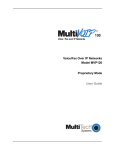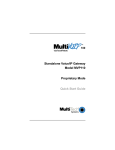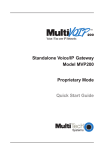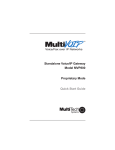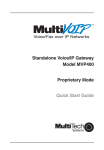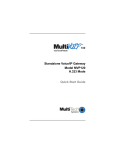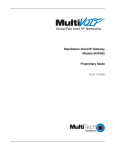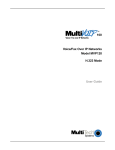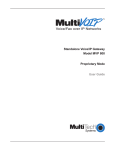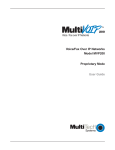Download Multitech MultiVOIP 100 MVP120 User guide
Transcript
Standalone Voice/IP Gateway Model MVP120 Proprietary Mode Quick Start Guide Quick Start Guide PN 82060550 Revision A MultiVOIP 100 Model MVP120 Copyright This publication may not be reproduced, in whole or in part, without prior expressed written permission from Multi-Tech Systems, Inc. All rights reserved. Copyright © 2001, by Multi-Tech Systems, Inc. Multi-Tech Systems, Inc. makes no representations or warranties with respect to the contents hereof and specifically disclaims any implied warranties of merchantability or fitness for any particular purpose. Furthermore, Multi-Tech Systems, Inc. reserves the right to revise this publication and to make changes from time to time in the content hereof without obligation of Multi-Tech Systems, Inc. to notify any person or organization of such revisions or changes. Revision A Date 08/10/01 Description Initial Release. Patents This Product is covered by one or more of the following U.S. Patent Numbers: 6151333, 5757801, 5682386. Other Patents Pending. Trademarks Trademark of Multi-Tech Systems, Inc. is the Multi-Tech logo. Windows is a registered trademark of Microsoft. Technical Support Multi-Tech Systems has an excellent staff of technical support personnel available to help you get the most out of your Multi-Tech product. If you have any questions about the operation of this unit or experience difficulty during installation, you can contact Tech Support via the following: Country France: India: U.K.: U.S. & Canada: Rest of World: By Email By Telephone [email protected] (33) 1-64 61 09 81 [email protected] (91) 124-340778 [email protected] (44) 118 959 7774 [email protected] (800) 972-2439 [email protected] (763) 785-3500 World Headquarters Multi-Tech Systems, Inc. 2205 Woodale Drive Mounds View, Minnesota 55112 (763) 785-3500 or (800) 328-9717 U.S. Fax 763-785-9874 http://www.multitech.com Contents Introduction ................................................................................... 4 Related Documentation ................................................................. 5 Overview ....................................................................................... 6 Unpacking Your MultiVOIP ............................................................ 8 Safety Warnings ............................................................................ 8 Cabling Your MultiVOIP ................................................................. 9 Software Installation ..................................................................... 11 Configuring the Host MultiVOIP .................................................. 16 Configuring the Client MultiVOIPs ............................................... 29 Deploying the VOIP Network ....................................................... 37 VOIP Administrator ............................................................... 37 Remote Site Administrator .................................................... 38 Limited Warranty ......................................................................... 39 FCC Declaration .......................................................................... 39 MultiVOIP Quick Start Guide Introduction The MultiVOIP model MVP120 enables FXO-only analog voice and fax communication over an IP network. Multi-Tech’s new voice/fax gateway technology allows voice and fax communication to ride, with no additional expense, over your existing IP network, which has traditionally been data-only. To access this free voice and fax communication, all you have to do is connect the MultiVOIP to your telephone equipment, and then to your existing Internet connection. Once configured, the MultiVOIP then allows voice and fax to travel down the same path as your traditional data communications. The MVP120 has one independent voice/fax channel, a 10 Mbps Ethernet LAN interface, and a command port for configuration. System management is provided through the command port using bundled Windows® software which provides easy-to-use configuration menus and online Help. Figure 1. MultiVOIP 4 Introduction Related Documentation The MVP120 Quick Start Guide is intended to be used by qualified systems administrators and network managers. This quick start guide provides the necessary information for a qualified person to unpack, cable, load software, and configure the unit for proper operation. A detailed MVP120 User Guide is also provided on the system CD with your unit and provides in-depth information on the features and functionality of Multi-Tech’s MultiVOIP. The User Guide is produced using Adobe AcrobatTM. To view or print your copy of a user guide, install Acrobat ReaderTM on your computer. The Acrobat Reader is included on your system CD or is available as a free download from Adobe’s Web site: http://www.adobe.com The MVP120 User Guide is also available on Multi-Tech’s Web site: http://www.multitech.com 5 MultiVOIP Quick Start Guide Overview Install Your MultiVOIP The basic steps of installing your MultiVOIP network involve unpacking the units, connecting the cables, and configuring the units using the included management software (MultiVOIP Configuration). The recommended installation process includes three phases that, when completed, result in a fully functional Voice Over IP network. A general description of each phase is provided below, and detailed instructions follow throughout the rest of this section. Configure and Install Your Host MultiVOIP First, the VOIP administrator configures the MultiVOIP designated as the “Host” unit. This includes the assignment of a unique LAN IP address, subnet mask, and Gateway IP address. Once the VOIP is configured, the administrator builds the Phone Directory Database that will reside with the Host unit. Configure Your Client MultiVOIPs Once installation has been completed, the administrator moves on to configure the MultiVOIPs designated as “Client” units. Again, this includes the assignment of unique LAN IP addresses, subnet masks, and a Gateway IP address. When this is done, the Phone Directory Database option is set to Client, and the IP address of the Host MultiVOIP is entered. Once all Client units are configured, the VOIP network can be deployed. 6 Introduction Deploy the VOIP Network The final phase of the installation is deployment of the network. Through the first two phases, the VOIP administrator controls configuration, so when the Client MultiVOIPs are sent to their remote sites, the remote site administrators need only to connect the units to their LAN and telephone equipment. A full Phone Directory Database (supplied by the Host MultiVOIP) will be loaded into their unit within minutes of being connected and turned on. The final task of the VOIP Administrator is to develop the VOIP Dialing Directory based on the Phone Directory Database and telephone numbers of the interfacing telephone equipment, at which point, a VOIP user can call any person on the VOIP network. 7 MultiVOIP Quick Start Guide Unpacking Your MultiVOIP Remove all items from the box (See Figure 2). Figure 2. Unpacking Safety Warnings Caution: Danger of explosion if battery is incorrectly replaced. A lithium battery on the voice/fax channel board provides backup power for the time keeping capability. The battery has an estimated life expectancy of ten years. When the battery starts to weaken, the date and time may be incorrect. If the battery fails, the board must be sent back to Multi-Tech Systems for battery replacement. Note: The Command and Ethernet ports are not designed to be connected to a Public Telecommunication Network. FXO can be connected to a PBX/FXO port or PSTN Network. 8 Cabling Cabling Your MultiVOIP Cabling your MultiVOIP involves making the proper connections for power, the command port, the FXO/PBX or PSTN system, and the Internet. Figure 3 shows the back panel connectors and the associated cable connections. The following procedure details the steps necessary for cabling your MultiVOIP. 1. Connect the power supply to a live AC outlet, and then connect it to the MultiVOIP as shown in Figure 3. Figure 3. Cable Connections 9 MultiVOIP Quick Start Guide 2. Connect the MultiVOIP to a PC using the RJ-45 to DB9 (female) cable provided with your unit. Plug the RJ-45 end of the cable into the Command port of the MultiVOIP and connect the other end to the PC serial port you are using. See Figure 3. 3. Connect a network cable to the Ethernet connector on the back of the MultiVOIP. Connect the other end of the cable to your network. 4. Connect an RJ-11 cable to the Voice/Fax Channel connector on the back of the MultiVOIP and the other end to the PSTN or FXO/PBX port. 5. Turn on power to the MultiVOIP by setting the power switch on the right side panel to the On position. Wait for the Boot LED on the MultiVOIP to go off before proceeding. This may take a couple of minutes. Note: If the Ethernet connection is not active, none of the LEDs will be on after booting. This unit does not have a Power LED. 10 Software Installation Software Installation This section covers software installation. Additional information on the MultiVOIP software is provided in the User Guide supplied with your MultiVOIP. Note: If you are installing a MultiVOIP behind a firewall, you need to add the following UDP ports to your firewall. 900 Signaling Information 5004 RTP Packets 5000 Status Information 5005 RTCP Packets Refer to your firewall user documentation to enter and open these ports. 1. Make certain that your MVP120 has been properly cabled and that the power is turned on. Note: If the Ethrenet connection is not active, none of the LEDs will be on after booting. This unit does not have a Power LED. 2. Insert the MVP120 CD into your CD-ROM drive. The CD should start automatically. It may take 10 to 20 seconds for the installation window to display. 11 MultiVOIP Quick Start Guide If the Multi-Tech Installation CD window does not appear automatically, click My Computer, then right-click the CDROM drive icon, click Open, then click the Autorun icon. 3. When the Multi-Tech Installation CD window displays, click the Install Software icon. 3a. Click Install Software. 3b. Check Proprietary, and then click OK. 4. The MultiVOIP Welcome window displays. Press Enter or click Next to continue. 12 Software Installation 5. Follow the on-screen instructions to install your MultiVOIP software. You can either choose the Destination Location of your MVP120 software or select the default destination by clicking Next. If you click Browse, you can select a different destination folder for the MVP120 software. 13 MultiVOIP Quick Start Guide 6. The Setup dialog box enables you to select the COM port of your PC that is connected to the Command port of the MVP120. From the Select Port list, select the COM port of your PC. Click OK to continue. 7. The Setup Complete dialog displays. Click Finish. 14 Software Installation 8. The following message displays. Click No to continue. 9. In the Program group, double-click Upgrade Software. This loads the Proprietary software. 10. The following message displays. Click Yes to continue. 11. The IP Protocol Default Setup dialog box displays next (see page 16) as you continue configuring your MultiVOIP. 15 MultiVOIP Quick Start Guide Configuring the Host MultiVOIP The following steps provide instructions for configuring your MVP120. The configuration sequence includes IP Protocol default setup, Channel setup, and Phone Directory Database setup. 12. The IP Protocol Default Setup dialog box displays. The default Frame Type is TYPE_II. If this does not match your IP network, change the Frame Type by selecting SNAP from the Frame Type list. The available Frame Type choices are TYPE_II and SNAP. 13. In the Ethernet group, enter your unique LAN IP address in the IP Address box, then enter the Subnet Mask and Gateway Address for your LAN in the corresponding boxes. The IP address is your unique LAN IP address, and the Gateway address is the IP address of the device connecting your MultiVOIP to the Internet. Click OK when you are finished. 14. The Channel Setup dialog box displays. The four tabs in this dialog box define the channel interface, voice/fax parameters, billing/security parameter, and regional telephone parameters (tone pairs). 16 Configuring the Host MultiVOIP 15. Check with your in-house phone personnel to verify whether your local PBX dial signaling is Pulse or DTMF (tone). Select the Regeneration option accordingly. In the Max Dial Digits box, enter the maximum number of digits allowed when dialing a phone number. The default number is 5. In the Inter Digit Time option defines the maximum amount of time between dialed digits that the unit will wait before mapping the dialed digits to an entry in the Phone Directory Database. If too much time elapses between digits, the wrong number will be mapped and you will hear a rapid busy signal. If this happens, hang up and dial again. The default setting is 2 seconds. In the Flash Hook Timer box, enter the amount of time for the duration of the flash hook signals output on the FXO interface. The default setting is 600 milliseconds. 17 MultiVOIP Quick Start Guide For FXO-to-FXO communications, you can enable a specific FXO Disconnect: Fix Current Loss, Tone Detection, or Silence Detection. Check with your inhouse phone personnel to verify the type of disconnect to use. If Current Loss is checked, the VOIP will hangup when it detects a loss of current on the FXO/phone port. For Tone Detection, select from the drop down list box one or two tones that will cause the line to disconnect. The person hanging up the call must then press the key or keys that produce those tones to hang up a call. For Silence Detection, select One Way or Two Way. Then enter in the Silence Timer box the number of seconds of silence before disconnect. The default value of 15 seconds may be shorter than desired for your application. To dedicate the local voice/fax channel to a remote voice/ fax channel, (so you will not have to dial the remote channel) select the Auto Call Enable check box. Enter the phone number of the remote VOIP in the Phone Number box. 16. The Voice/Fax tab displays the parameters for the voice gain, DTMF (Dual Tone Multi-Frequency) gain, voice coder, faxing, and advanced features such as Silence Compression, Echo Cancellation, and Forward Error Correction. 18 Configuring the Host MultiVOIP To change the voice coder, select the new voice coder entry from the Voice Coder list. If you change the voice coder, ensure that the same voice coder is used on the voice/fax channel you are calling. Otherwise, you will get a busy signal. Note: If Automatic Coder is selected, enter the bandwidth in the Max Bandwidth box. Check with your Network Administrator to determine available bandwidth. You can set up the Input Gain and Output Gain so that the volume can be increased or decreased. Input gain modifies the level of the audio coming into the voice channel before it is sent over the Internet to the remote MultiVOIP. Output gain modifies the level of the audio being output to the device attached to the voice channel. Make your selections from the Input and Output dropdown lists in the Voice group. The valid range is +31dB to –31dB with a recommended/default value of 0. 19 MultiVOIP Quick Start Guide 17. The Fax group enables you to select the maximum baud rate for faxes and adjust the fax volume. If you do not plan to send or receive faxes on a given voice/fax channel, you can disable faxes in the Fax group. 18. The Miscellaneous group lets you set voice/fax advanced features by clicking (checking) Silence Compression, Echo Cancellation, or Forward Error Correction. The Silence Compression option defines whether silence compression is enabled for the voice channel. If silence compression is enabled, the MVP120 will not transmit voice packets when silence is detected, thereby reducing the amount of network bandwidth used by the voice channel. The Echo Cancellation option defines whether echo cancellation is enabled for the voice channel. If echo cancellation is enabled, the MVP120 will remove echo which improves the quality of sound. The Forward Error Correction (FEC) option defines whether forward error correction is selected for the voice channel. The FEC feature allows some of the voice packets that were corrupted or lost to be recovered. FEC adds an additional 50% overhead to the total network bandwidth consumed by the voice channel. 20 Configuring the Host MultiVOIP 19. The Billing/Security tab displays the parameters for billing options, call authentication, and automatic disconnection. 20. You can set up billing options for inbound and outbound calls by selecting them in the Billing Options group and then entering the charge in cents per number of seconds. 21. The Call Authentication option enables password protection for outbound and inbound calls on the selected voice/fax channel. If you enable password protection on inbound or outbound calls, you need to enter a password of up to 14 numeric characters in the Password box. 22. The Automatic Disconnect option limits call duration to the number of seconds entered in the Disconnect After box. The default value of 180 seconds can be changed to any other value up to 65,535 (roughly 18.2 hours). 21 MultiVOIP Quick Start Guide 23. Click the Regional Tab to change the Tone Pairs and to select your country/region from the Country/Region list. The Tone Pairs group enables you to select and modify the parameters. Click OK when finished. Click OK. The upgrade takes several minutes to complete. 24. From the Program group, double-click MultiVOIP Configuration. Click Phone Book. The Phone Directory Database dialog box displays. You will build your personalized MultiVOIP Phone Directory in the following steps. Note: The MultiVOIP configured as a “Host” will contain the host database. The host database has the phone numbers of all the MultiVOIPs available for communication on an IP network. This database is downloaded to each Client MultiVOIP as it comes online. 22 Configuring the Host MultiVOIP Click Add to begin building your phone directory database. 25. The Add/Edit Phone Entry dialog box displays. 23 MultiVOIP Quick Start Guide In the Station Information group, enter the unique phone number of the local device connected to Channel 1 in the Phone Number box. For example phone number 101. 26. The Description is optional, but can be useful in associating the channel to the extension. 27. Enter the Voice Channel number corresponding to the phone number entered. 28. Click the Permit Hunting box if you want calls to roll over to a second voice/fax channel on an 2, 4, or 8-port client answering MultiVOIP when the first channel is busy. Note: Hunting will work between channels on the same MultiVOIP. However, hunting between channels on separate MultiVOIPs is not supported in proprietary mode. Note: The Host MultiVOIP must have a static IP address that the remote MultiVOIP can reference to obtain a downloaded copy of the host phone directory database. 29. In the MultiVOIP Identification group, enter the IP address of the Host MultiVOIP in the IP Address box. Then obtain the 12-digit Node ID# (0008005xxxxx) from the ID plate on the back panel of the MultiVOIP and enter this number in the Ethernet Node ID box. If the ID plate is missing or damaged, you can also Telnet to the MultiVOIP and, on the MultiVOIP Telnet Server menu enter 1 to advance to the Main Menu, then enter 3 for System Information where item 1 is the Ethernet Port Address you want to enter in the Ethernet Node ID box. 24 Configuring the Host MultiVOIP 30. Click OK and you are returned to the Phone Directory Database dialog box, which now includes phone number 101 with its IP address, channel number, and description. 25 MultiVOIP Quick Start Guide 31. Click Add and the Add/Edit Phone Entry dialog box displays again. 32. Enter the phone number for the remote MultiVOIP in the Station Information group Phone Number box. For example, 102. 33. Enter a description for the remote MultiVOIP phone number in the Description box. Note: If the remote MultiVOIP is located behind a proxy server that uses a dynamically assigned IP address, select Dynamic (disabling Static IP Address) and leave the IP Address box blank. The Host MultiVOIP will learn the IP address when it is contacted by the remote MultiVOIP. 34. Enter the IP address of the remote MultiVOIP in the IP Address box in the MultiVOIP Identification group. 35. Click OK and you are returned to the Phone Directory Database dialog box, which now includes the second number and related information in the Phone Number list. 26 Configuring the Host MultiVOIP 36. When you have finished, click OK. On the Main menu, click Download Setup. 37. The Save Setup dialog box displays. Click OK to proceed. 27 MultiVOIP Quick Start Guide 38. After the setup is written to the MultiVOIP, the unit is rebooted. 39. Verify that the BOOT LED on the MultiVOIP is off after the download is complete. This may take several minutes as the MultiVOIP reboots. Note: If the Ethernet connection is not active, none of the LEDs will be on after booting. This unit does not have a Power LED. 40. You are returned to your MultiVOIP folder which is open and visible on your desktop. At this time, your host MultiVOIP is configured. Proceed to the next section to configure the client MultiVOIPs. 28 Configuring the Client MultiVOIPs Configuring the Client MultiVOIPs If you are installing a MultiVOIP behind a firewall, you need to add the following UDP ports to your firewall. 900 Signaling Information 5000 Status Information 5004 RTP Packets 5005 RTCP Packets Refer to your firewall user documentation to enter and open these ports. 1. Disconnect the PC from the command port of the Host MultiVOIP and connect it to the command port on the Client MultiVOIP. 2. From your desktop, click Start | Programs I MultiVOIP I Upgrade Software. The following dialog box displays. 3. Click Yes. The IP Protocol Default Setup dialog box displays. The default Frame Type is TYPE_II. If this does not match your IP network, select the Frame Type from the Frame Type list. The Frame Type choices are TYPE_II and SNAP. 29 MultiVOIP Quick Start Guide 4. In the Port Address group, enter the IP Address and IP Mask. In the Gateway Address group, enter the gateway IP address for the client unit. The IP address is your unique LAN IP address, and the Gateway address is the IP address of the device connected to the Internet/Intranet. Click OK when you are finished. The Channel Setup dialog box displays. 5. The Channel Setup dialog box defines the voice coder, fax parameters, and regional telephone parameters for the voice/fax channel. 6. Check with your in-house telephone personnel to verify whether your local PBX dial signalling is Pulse or DTMF (tone). Select the regeneration option accordingly. 30 Configuring the Client MultiVOIPs In the Max Dial Digits box, enter the maximum number of digits allowed when dialing a phone number. The default setting is 5. In the Inter Digit Time box, enter the maximum amount of time between dialed digits in milliseconds that the unit will wait before mapping the dialed digits to an entry in the Phone Directory Database. If too much time elapses between digits and the wrong numbers are mapped, you hear a rapid busy signal. If this happens, hang up and dial again. This option is available for all interface types. In the Flash Timer box, enter the time, in milliseconds, for the duration of flash hook signals output on the interface. For FXO-to-FXO communications, you can enable a specific FXO Disconnect: Current Loss, Tone Detection, or Silence Detection. Check with your inhouse phone personnel to verify the type of disconnect to use. If Current Loss is checked, the VOIP will hang up when it detects a loss of current on the FXO/phone port. For Tone Detection, select from the drop down list box one or two tones that will cause the line to disconnect. The person hanging up the call must then press the key or keys that produce those tones to hang up a call. For Silence Detection, select One Way or Two Way. Then enter in the Silence Timer box the number of seconds of silence before disconnect. The default value of 15 seconds may be shorter than desired for your application. To dedicate the local voice/fax channel to a remote voice/ fax channel, (so you will not have to dial the remote channel) select the Auto Call Enable check box. Enter the phone number of the remote VOIP in the Phone Number box. 7. The Voice/Fax tab displays the parameters for the voice coder, faxing, DTMF (Dual Tone Multi-Frequency) gain, and the miscellaneous advanced features Silence Compression, Echo Compression, and Forward Error Correction. 31 MultiVOIP Quick Start Guide To change the voice coder, select the new voice coder entry from the Voice Coder list. If you changed the voice coder, ensure that the same voice coder is used on the voice/fax channel you are calling. Otherwise, you will always get a busy signal. Note: If Automatic Coder is selected, enter the bandwidth in the Max Bandwidth box. Check with your Network Administrator to determine available bandwidth. 8. The Fax group enables you to select the maximum baud rate for faxes and adjust the fax volume. If you do not plan to send or receive faxes on a given voice/fax channel, you can disable faxes in the Fax group. 9. The Billing/Security tab displays the parameters for billing options, call authentication, and automatic disconnection. 32 Configuring the Client MultiVOIPs 10. You can set up billing options for inbound and outbound calls by selecting them in the Billing Options group and then entering the charge in cents per number of seconds. 11. The Call Authentication option enables password protection for outbound and inbound calls on the selected voice/fax channel. If you enable password protection on inbound or outbound calls, you need to enter a password of up to 14 numeric characters in the Password box. 12. The Automatic Disconnect option limits call duration to the number of seconds entered in the Disconnect After box. The default value of 180 seconds can be changed to any other value up to 65,535 (roughly 18.2 hours). 13. Click the Regional tab to select your specific country/ region from the Country/Region list or to change the Tone Pairs. 33 MultiVOIP Quick Start Guide The Tone Pairs group parameters change per your selections. Click OK. The following dialog box displays. 14. Click OK. After the download is completed, click Start | Programs | MultiVOIP | MultiVOIP Configuration. On the main menu, click Phone Book to display the Phone Directory Database dialog box. 34 Configuring the Client MultiVOIPs . xobxob In the Database Type group, click the Client option. The Host IP Address box becomes active 15. Enter the IP address of the host MultiVOIP in the Host IP Address box. 16. Click OK and you are returned to the main menu. 35 MultiVOIP Quick Start Guide 17. Click Download Setup to write the new configuration to the client unit. The Save Setup dialog box displays. 18. Select the Save Current Setup as User Default Configuration check box and click OK. After the setup is written to the MultiVOIP, the unit reboots. 19. Verify that the Boot LED on the MultiVOIP is off after the download is complete. This may take several minutes as the MultiVOIP reboots. 20. You are returned to the main menu. Your MultiVOIP is operational at this time. Repeat this procedure for each of the client units. When all clients have been configured, proceed with deploying the VOIP network. 36 Deploying the VOIP Network Deploying the VOIP Network Deploying the VOIP network involves the VOIP Administrator developing the VOIP Dialing Directory and deploying the preconfigured client MultiVOIPs to their remote sites. The remote site administrators need only connect power to the preconfigured MultiVOIP, connect it to their Ethernet LAN and predefined telephone equipment, and then wait for the phone directory database to be downloaded. Perform the following procedure to deploy your VOIP network. VOIP Administrator 1. Create your VOIP Dialing Directory based on your Phone Directory Database for the numbers to connect the MultiVOIPs to your VOIP network and the telephone extension number you need to connect the Voice/Fax channels. A sample VOIP Dialing Directory is provided below for your consideration and use. VOIP Dialing Directory To Call From Call Process Dialing Sequence 2. Send the client MultiVOIPs to their remote sites. 37 MultiVOIP Quick Start Guide Remote Site Administrator 1. Connect one end of the power supply to a live AC outlet and connect the other end to the Power connection on your MultiVOIP. Figure 4. Remote Site Cable Connection 2. Connect a network cable to the ETHERNET 10Base-T (RJ-45) connector on the back of your MultiVOIP. 3. If you are connecting to a PSTN or PBX/FXO port, connect one end of an RJ-11 cable to the Phone connector on the back of the MultiVOIP and the other end to the PSTN or PBX/FXO port. 4. Turn on power to the MultiVOIP by placing the ON/OFF switch on the right side panel in the ON position. Wait for the Boot LED on the MultiVOIP to go off before proceeding. This may take a couple of minutes. 5. At this time your VOIP network should be fully operational. Dial one of the sites in your network using the dialing directory supplied by your Network Administrator. 38 Warranty and Regulatory Information Limited Warranty Multi-Tech Systems, Inc. (“MTS”) warrants that its products will be free from defects in material or workmanship for a period of two years from the date of purchase, or if proof of purchase is not provided, two years from date of shipment. MTS MAKES NO OTHER WARRANTY, EXPRESSED OR IMPLIED, AND ALL IMPLIED WARRANTIES OF MERCHANTABILITY AND FITNESS FOR A PARTICULAR PURPOSE ARE HEREBY DISCLAIMED. This warranty does not apply to any products which have been damaged by lightning storms, water, or power surges or which have been neglected, altered, abused, used for a purpose other than the one for which they were manufactured, repaired by the customer or any party without MTS’s written authorization, or used in any manner inconsistent with MTS’s instructions. MTS’s entire obligation under this warranty shall be limited (at MTS’s option) to repair or replacement of any products which prove to be defective within the warranty period, or, at MTS’s option, issuance of a refund of the purchase price. Defective products must be returned by Customer to MTS’s factory transportation prepaid. MTS WILL NOT BE LIABLE FOR CONSEQUENTIAL DAMAGES AND UNDER NO CIRCUMSTANCES WILL ITS LIABILITY EXCEED THE PURCHASE PRICE FOR DEFECTIVE PRODUCTS. FCC Declaration NOTE: This equipment has been tested and found to comply with the limits for a Class A digital device, pursuant to Part 15 of the FCC Rules. These limits are designed to provide reasonable protection against harmful interference when the equipment is operated in a commercial environment. This equipment generates, uses and can radiate radio frequency energy, and if not installed and used in accordance with the instructions, may cause harmful interference to radio communications. Operation of this equipment in a residential area is likely to cause harmful interference in which case the user will be required to correct the interference at his own expense. Warning: Changes or modifications to this unit not expressly approved by the party responsible for compliance could void the user’s authority to operate the equipment. 39 82060550








































